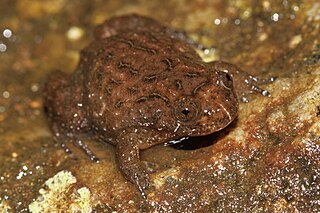
The hairy-legged vampire bat is one of three extant species of vampire bats. It mainly feeds on the blood of wild birds, but can also feed both on domestic birds and humans. This vampire bat lives mainly in tropical and subtropical forestlands of South America, Central America, and southern Mexico. It is the sole member of the genus Diphylla.

Nannophrys guentheri is an extinct species of frog in the family Dicroglossidae. It was endemic to Sri Lanka. The species was first identified in 1882 by George Boulenger and named after the German-born British zoologist Albert Günther. It is not known where in Sri Lanka the specimens were found.

Nyctibatrachus deccanensis is a species of frogs in the family Nyctibatrachidae. It is endemic to the southern Western Ghats in Tamil Nadu and Kerala states, India. Its natural habitats are tropical moist lowland forests, moist montane forests, and rivers. It is threatened by habitat loss.
Paleontology or palaeontology is the study of prehistoric life forms on Earth through the examination of plant and animal fossils. This includes the study of body fossils, tracks (ichnites), burrows, cast-off parts, fossilised feces (coprolites), palynomorphs and chemical residues. Because humans have encountered fossils for millennia, paleontology has a long history both before and after becoming formalized as a science. This article records significant discoveries and events related to paleontology that occurred or were published in the year 1890.

Pterolophia is a genus of longhorn beetles of the subfamily Lamiinae, containing the following species:
Pterolophia albovariegata is a species of beetle in the family Cerambycidae. It was described by Stephan von Breuning in 1938.
Pterolophia lepida is a species of beetle in the family Cerambycidae. It was described by Breuning in 1938. It is known from the Ivory Coast, the Central African Republic, Cameroon, and the Republic of the Congo. It feeds on Celtis zenkeri. It contains the varietas Pterolophia lepida var. szewezycki.
Pterolophia strumosa is a species of beetle in the family Cerambycidae. It was described by Francis Polkinghorne Pascoe in 1865, originally under the genus Praonetha. It is known from Australia. It contains the varietas Pterolophia strumosa var. blackburni.
Pterolophia ingrata is a species of beetle in the family Cerambycidae. It was described by Francis Polkinghorne Pascoe in 1864.
Pterolophia melanura is a species of beetle in the family Cerambycidae. It was described by Francis Polkinghorne Pascoe in 1857. It has a wide distribution in Asia.
Pterolophia undulata is a species of beetle in the family Cerambycidae. It was described by Francis Polkinghorne Pascoe in 1862. It is known from Moluccas.
Pterolophia gibbosipennis is a species of beetle in the family Cerambycidae. It was described by Maurice Pic in 1926.
Pterolophia instabilis is a species of beetle in the family Cerambycidae. It was described by Per Olof Christopher Aurivillius in 1922. It is known from Seychelles.
Pterolophia lateralis is a species of beetle in the family Cerambycidae. It was described by Charles Joseph Gahan in 1895. It has a wide distribution in Asia.
Pterolophia angulata is a species of beetle in the family Cerambycidae. It was described by Hermann Julius Kolbe in 1893. It has a wide distribution in Africa. It feeds on Lagerstroemia indica.
Pterolophia caudata is a species of beetle in the family Cerambycidae. It was described by Henry Walter Bates in 1873.
Pterolophia guineensis is a species of beetle in the family Cerambycidae. It was described by James Thomson in 1864, originally under the genus Alyattes.
Pterolophia kaleea is a species of beetle in the family Cerambycidae. It was described by Henry Walter Bates in 1866, originally under the genus Praonetha.
Pterolophia lateripicta is a species of beetle in the family Cerambycidae. It was described by Léon Fairmaire in 1879, originally under the genus Oopsis. It is known from Fiji.
Pterolophia rustenburgi is a species of beetle in the family Cerambycidae. It was described by William Lucas Distant in 1898.





